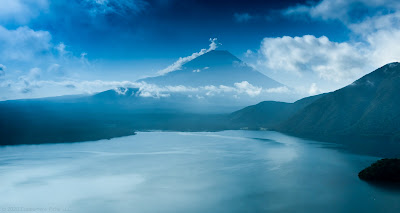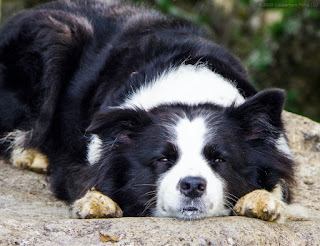After a nearly 5-hour drive, we finally reached the trailhead to Mt. Banjirodake. One of the best things about this location is that there is a designated parking lot just for hikers--it is free, has clean restrooms, and has basins for washing mud off of your gear and shoes.
Mt. Banjirodake:
Designated Parking:
The trail started out very easy. After about an hour, the trail became steeper but not that challenging. The difficult part was that the trail had been severely eroded by rain. In some locations, you have to walk off the trail and find an alternate path to get back on the trail while climbing over huge boulders. I am sure it will take a long time and significant expense to get the trail back to its original condition.
Ascending the mountain, I didn't stop to take any photos. The climb up was to scout for compositions that I could shoot on the way down the mountain.
After reaching the peak, I was a bit disappointed. The view of the ocean was bleak and hazy. The sky was misty and no nice cloud cover. I might have been able to find some decent shots, but I was soaking wet with sweat which seemed to attract small flying insects (gnats? flies?) that made it impossible to stand still long enough to set up the tripod for some carefully composed shots. I don't recall being swarmed by so many insects at one time. They didn't bite or sting, but were incredibly maddening.
I gave up on spending the time needed to set up the tripod and focus on some carefully planned compositions. Rather, I took a run-and-gun approach with handheld shots while trying to avoid standing still long enough to be engulfed by the flying insects.
On the way down, we were able to finally escape the swarm of insects that were at the top of the mountain and finally had a chance to take out the tripod for some interesting shots while giving the dog and myself some rest. Although coming down the mountain was easier than climbing, I had to be very careful that I did not go too fast and injure my knees as I had to climb down some steep grades and hop off of big boulders blocking the trail.
Here are the few shots that I was able to take with so-so quality. I would like to go again in the fall when the air is dryer and maybe the fall leaves might add to more dramatic shots.
Beech Woods
Beech wood tree on peak of Mt. Banjirodake (at elevation of 1,299 m/4,262 ft). This peak is located on the Amagi Mountain Range, which is located on the Izu Peninsula in Shizuoka Prefecture (approx. a 3.5 hour drive southwest of Tokyo).
Pentax KP 31mm ISO 100 for 1/40 sec. at ƒ/4.5
#mountain #hiking #Banjirodake #trees #beechwood #Izu #Shizuoka #Japan
#山 #ハイキング # 万二郎岳 #木 #天城の秘境 #ブナの木 #伊豆半島 #静岡県
Tired
We had driven all night and reached the trailhead at about 5:00 in the morning. Four hours later we reached the peak of Mt. Banjirodake. She seemed exhausted and quickly found a huge, cool boulder to rest on while I was taking photos.
Pentax KP 135mm ISO 1600 for 1/200 sec. at ƒ/5.6
#dog #pet #bordercollie #MtBanjirodake #Shizuoka #Japan
#犬 #ワンちゃん #愛犬 #ボーダーコリー #万二郎岳 #伊豆半島 #静岡県
Moss
This shot was taken at about 1,200 meters (3,937 ft) where you can see many species of moss creating new life from dead trees in an old growth forest that was spared the destruction of cedar tree plantations found at lower elevations.
Pentax KP 68mm ISO 800 for 1/200 sec. at ƒ/5.6
#moss #tree #oldgrowth #forest #MtBanjirodake #Izu #Shizuoka #Japan
#苔 #コケ #古い成長の木 #森 #万二郎岳 #伊豆半島 #静岡県
Happy to Go Home
お二人(僕とワンちゃん)はとても最高でした!
Halfway down Mt. Banjirodake, she jumped up onto this boulder and waited for me to catch up with her. On the way up the mountain, we both kept about the same pace. But on the way down, I with my backpack full of gear and my careful navigation of muddy rocks on the trail were no match for a spry border collie!
Pentax KP 36 mm ISO 1600 for 1/60 sec. at ƒ/4.5
#dog #pet #bordercollie #MtBanjirodake #Shizuoka #Japan
#犬 #ワンちゃん #愛犬 #ボーダーコリー #万二郎岳 #伊豆半島 #静岡県

Stewartia Monadelpha
On the climb down Mt. Banjirodake, came across a few very tall and unusual trees known as tall stewartia (Species: Stewartia monadelpha) that are native to the tropical mountain regions of Japan. The smooth, cinnamon colored trunks reach far above the canopy and stand in stark contrast to the surrounding cedar and beech woods.
Pentax KP 21mm ISO 400 for 1/50 sec. at ƒ/5.6
#stewartia #tree #oldgrowth #forest #MtBanjirodake #Izu #Shizuoka #Japan
#ヒメシャラ #姫沙羅 #古い成長の木 #森 #万二郎岳 #伊豆半島 #静岡県
Stewartia Monadelpha
This is the second stewartia tree I discovered on the way down Mt. Banjirodake. Don't know how I missed this tree on the way up! Was probably too focused trying to secure sure footing on the washed out trail. Hope to visit another old growth forest if I can.
Pentax KP 48 mm ISO 1600 for 1/30 sec. at ƒ/8.0
#stewartia #tree #oldgrowth #forest #MtBanjirodake #Izu #Shizuoka #Japan
#ヒメシャラ #姫沙羅 #古い成長の木 #森 #万二郎岳 #伊豆半島 #静岡県





























